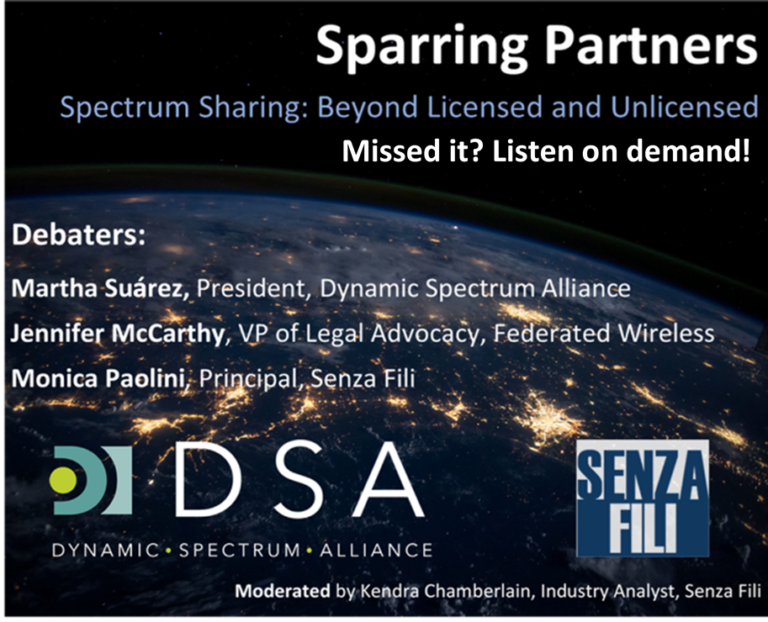 A recap of Senza Fili’s Sparring Partners Webinar.
A recap of Senza Fili’s Sparring Partners Webinar.
Last week, we were pleased to participate in Senza Fili’s latest webinar, covering the importance of connectivity in our lives and how spectrum can be used to facilitate better connections between people and communities. Hosted by Monica Paolini, Editor of Senza Fili, and moderated by Kendra Chamberlain on the first all-female panel, we discussed the benefits of spectrum sharing and how far the technology has come since the DSA first formed. We also explored different options and frameworks for dynamic spectrum management, including TVWS, CBRS, 6 GHz and database assisted dynamic spectrum networks. The full webinar is now available to watch and listen to on-demand here.
Our History
Traditionally, there have been only two approaches to spectrum management; licensed usage, which requires every user to have a license for a particular frequency band or geographic area, and unlicensed usage, where an entire frequency band is reserved exclusively for unlicensed operations. For example, the 2.4 and 5 GHz bands where Wi-Fi, Bluetooth, and other unlicensed devices operate stand as an existing example of unlicensed usage. Today, there are several approaches to spectrum management that include sharing between different types of services, blurring the line between the two traditional methods.
While it is still desirable to have bands dedicated to unlicensed access and some applications and use cases require exclusive or priority access to spectrum, it is difficult to find sufficient spectrum to support this. This is due to the vast number of users currently operating across all frequencies and the complex and onerous process of clearing or relocating users. Spectrum sharing technology can be used to combat this challenge, enabling spectrum to be shared efficiently among users while simultaneously protecting incumbents.
New spectrum access options must be considered for Wireless Internet Service Providers (WISPs) that are offering rural broadband connectivity. Such WISPs are dependent on having sufficient access to spectrum, as well as to well-developed equipment ecosystems.
New LTE and 5G networks can also benefit from the use of spectrum sharing technology, which helps to increase access to spectrum for existing Mobile Network Operators and support new business cases that have previously had limited spectrum access options. By building the right regulatory framework for spectrum sharing and creating good operating conditions for incumbents without interference, more users are able to benefit from spectrum access. Applicable to both residential and enterprise use cases, this allows different providers and companies to contribute to the network, connecting more people in different environments and facilitating the expansion of a richer spectrum ecosystem. Our society is now so dependent on wireless technology that we must act to adapt it to our ever-evolving lifestyles, and the DSA advocates for a range of different options in doing so.
Gauging Dynamic Use
Today, dynamic spectrum sharing offers far more efficient options for providing opportunities to access frequency bands. In the CBRS framework, the ‘dynamic’ aspect refers to the nature of the incumbent use, which changes depending on time and location, requiring new users to adapt to fluctuating conditions and to access the spectrum under an opportunistic scheme. Dynamic users are harder to protect than static users, requiring different techniques to effectively protect them while still allowing new users in the same band. One such technique involves the detection of incumbents through the use of sensors. Once incumbent use is detected, spectrum sharing systems can instruct new users to relocate to a different part of the band on a temporary basis to avoid interference with incumbents.
New entrants can also benefit from dynamic sharing of spectrum. At times and in locations where incumbents are not using spectrum, spectrum sharing systems can assign it to others. This is especially applicable in stadiums or sporting venues where flexible spectrum access options are needed to cater to the large volume of users in one space for a limited period of time. Thus, the dynamic aspect of spectrum sharing not only protects incumbents, but also allows new entrants access when and where they need it, making far more efficient use of spectrum and eliminating waste.
Considering all the Options
Unlicensed technologies, such as Wi-Fi and TV White Space, are mature and continue to support vast numbers of users on an affordable basis. However, there are other types of spectrum sharing that enable new opportunities. Regional context is important for judging which is most appropriate for a particular country or frequency band. For example, frequency bands which are heavily occupied in the United States, such as the television broadcast bands, might only host a few national broadcasters in other countries. While many bands are being used extensively in big cities, that same spectrum might be readily available in rural or isolated regions. So long as the incumbent users are protected, spectrum sharing technologies can open large amounts of spectrum to new users.
Regulatory frameworks that involve spectrum sharing must be flexible and adaptable for future changes of both incumbent and new users. We must consider the importance of making sufficient spectrum available for both unlicensed access and 5G services – spectrum sharing technology can be leveraged to achieve both of these goals. As the influx of data and cutting-edge devices is projected to boost traffic being carried by Wi-Fi from 50% to 70%, we risk facing a shortage or bottleneck of spectrum. At the same time, in order to achieve the low latency, high power capabilities that are being imagined for the 5G era, access to spectrum in the entire 6 GHz band will be urgently needed. Shared spectrum solutions are available today that can help meet these challenges.